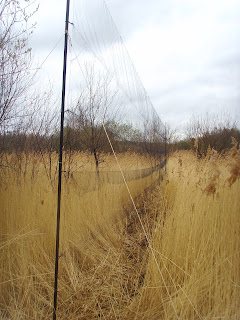Wow, what a morning. I've just returned from Linacre where, in a couple of hours, I've recorded my first
Chiffchaff of the year, a pair of nest building and mating
Mistle Thrush, my second ever Linacre
Curlew, a
Great-crested Grebe, also sat on a nest, and a queen
Red-tailed Bumblebee. phew!
The
Mistle Thrush record is particularly good because this is my first actual record of breeding behaviour at Linacre except for singing and being in the correct habitat at the right time of year. As well as this it's also the first time I've found their nest. The nest itself is about 15m up in the fork of a sycamore tree, so I won't be able to see in which is a pity because I'd really like to record its outcome for the
BTO's Nest Record Scheme. I should, however, be able to watch it with my 'scope and so I may be able to record some of the comings and goings. Here's a picture of the nest, well hidden behind the ivy.
Mistle Thrush nest
Curlew is a very uncommon species for Linacre and one that has never been recorded on the ground. My first record was in August 2011, when one was calling and flying over. Today's record was very similar with the bird being heard but not seen. I presume both records will have been local birds flying over "on passage" to their breeding grounds in the surrounding moorlands.
The
Chiffchaff record was my first of the year and came 5 days later than in 2011 (12th March, which is my earliest ever record and could have referred to an over wintering individual as it wasn't singing.)
Great-crested Grebes have been present every year since the group's recording began in 2006 and has nested on the reservoirs in 2009 and 2010. This year's nest is the earliest ever and my first in March. The eggs are normally incubated by both adults for about 29 days, so it should mid April before the chicks are seen. Let's see how it develops. Here's one of the adult birds sitting tight.
Great-crested Grebe
Other birds spotted today were:
Mallard (32),
Moorhen (7),
Coot (15),
Tufted Duck (6),
Mandarin (2),
Common Buzzard (calling),
Great-spotted Woodpecker (drumming), Tawny Owl ( a pair "twitt twooing"),
Pied Wagtail (singing male) and
Cormorant (1).
The Year List moved on 2 more species this week:
103: Stock Dove
104: Chiffchaff




















